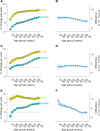Incidence of in Situ vs Invasive Melanoma: Testing the "Obligate Precursor" Hypothesis
- PMID: 36042554
- PMCID: PMC9552301
- DOI: 10.1093/jnci/djac138
Incidence of in Situ vs Invasive Melanoma: Testing the "Obligate Precursor" Hypothesis
Abstract
Background: Melanoma incidence has been rising in populations with predominantly European ancestry (White), speculated to be partly driven by heightened detection of indolent tumors. If in situ melanomas are destined to evolve to invasive cancers, detecting and removing them should deplete the pool of invasive lesions, and people with in situ melanoma should, on average, be younger than those with invasive melanoma.
Methods: We analyzed long-term incidence trends (1982-2018) for in situ and invasive melanomas in 3 predominantly White populations with high, medium, and low melanoma rates: Queensland (Australia), United States White, and Scotland. We calculated the incidence rate ratio (IRR) of in situ to invasive melanomas and estimated the contributions of age, period, and cohort effects. We compared age at diagnosis of in situ vs invasive melanomas overall and stratified by sex and anatomic site.
Results: In all 3 populations, the in situ to invasive incidence rate ratio increased statistically significantly from less than 0.3 in 1982 to 1.95 (95% confidence interval [CI] = 1.88 to 2.02) in Queensland, 0.93 (95% CI = 0.90 to 0.96) in the US White population, and 0.58 (95% CI = 0.54 to 0.63) in Scotland in 2018. The mean age at diagnosis of in situ melanomas was the same or higher than invasive melanomas for almost all time periods among men and women and on all body sites except the lower limbs.
Conclusions: The increasing ratio of in situ to invasive melanoma incidence over time, together with the high (and increasing) mean age at diagnosis of in situ melanomas, is consistent with more indolent lesions coming to clinical attention than in previous eras.
© The Author(s) 2022. Published by Oxford University Press.
Figures




Comment in
-
Obligate and Potential Precursors of Melanoma.J Natl Cancer Inst. 2022 Oct 6;114(10):1320-1322. doi: 10.1093/jnci/djac139. J Natl Cancer Inst. 2022. PMID: 36042556 Free PMC article. No abstract available.
References
-
- Whiteman DC, Green AC, Olsen CM. The growing burden of invasive melanoma: projections of incidence rates and numbers of new cases in six susceptible populations through 2031. J Invest Dermatol. 2016;136(6):1161-1171. - PubMed
-
- Yang DD, Salciccioli JD, Marshall DC, Sheri A, Shalhoub J. Trends in malignant melanoma mortality in 31 countries from 1985 to 2015. Br J Dermatol. 2020;183(6):1056-1064. - PubMed
-
- Aitken JF, Youlden DR, Baade PD, et al. Generational shift in melanoma incidence and mortality in Queensland, Australia, 1995-2014. Int J Cancer. 2018;142(8):1528-1535. - PubMed
-
- Sacchetto L, Zanetti R, Comber H, et al. Trends in incidence of thick, thin and in situ melanoma in Europe. Eur J Cancer. 2018;92:108-118. - PubMed
-
- Welch HG, Mazer BL, Adamson AS. The rapid rise in cutaneous melanoma diagnoses. N Engl J Med. 2021;384(1):72-79. - PubMed
Publication types
MeSH terms
LinkOut - more resources
Full Text Sources
Medical

